The Apple iPad Pro Review
by Ryan Smith, Joshua Ho & Brandon Chester on January 22, 2016 8:10 AM ESTSystem Performance Cont'd
Continuing on with our more game-like benchmarks, tests like 3DMark and GFXBench are supposed to replicate gaming workloads to help determine relative performance in most common 3D games. In the case of the iPad Pro, the GPU is a 12 cluster variant of the PowerVR Series7XT GPU architecture. This is double the number of clusters relative to the A9’s GPU, which should prove to be quite impressive judging by the GPU performance that we saw in the iPhone 6s.
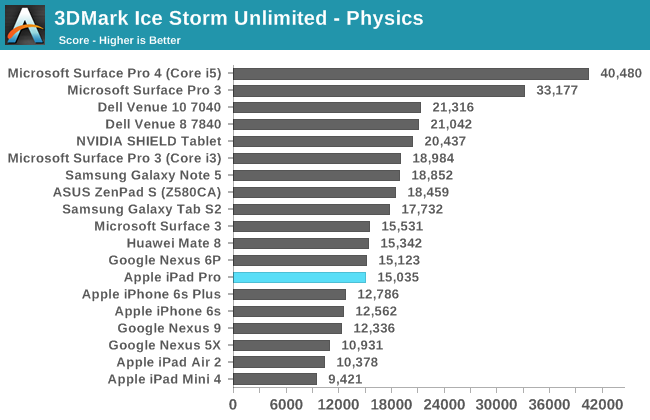
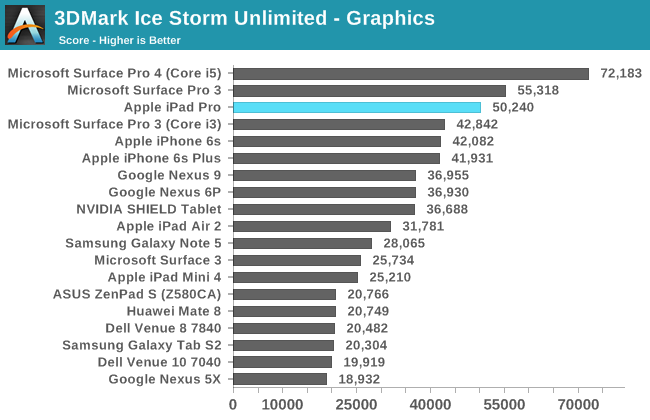
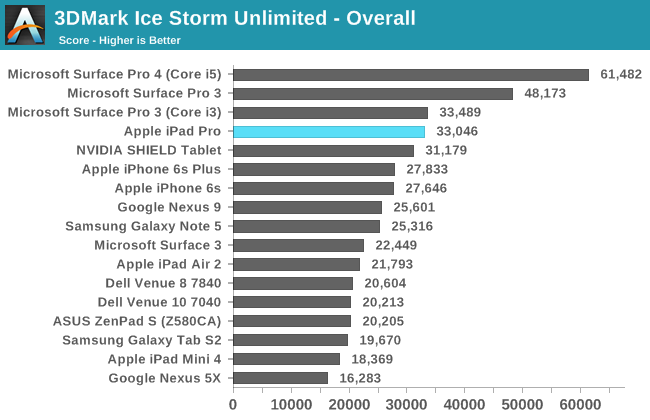
The iPad Pro manages to maintain superiority in 3DMark, but we're really starting to see the limitations of this test. The physics test generates non-sequential data structures with memory dependencies, which can penalize devices with lower core count and clock speed, but the workload is able to be spread across multiple cores to exploit TLP, which benefits devices with more real cores, or virtual ones (hyperthreading). We also see that the graphics test isn't really scaling well at this point as it's just too light to take advantage of the full potential of the A9X GPU. This likely also explains why the iPad Pro isn't closer to the Surface Pro 4 in performance on this benchmark, given what we know about A9X's GPU.
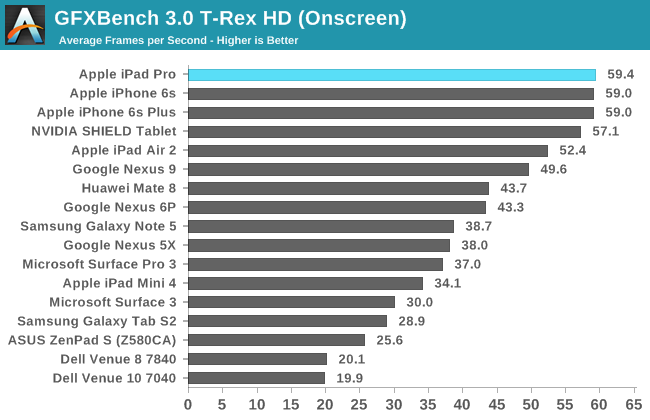
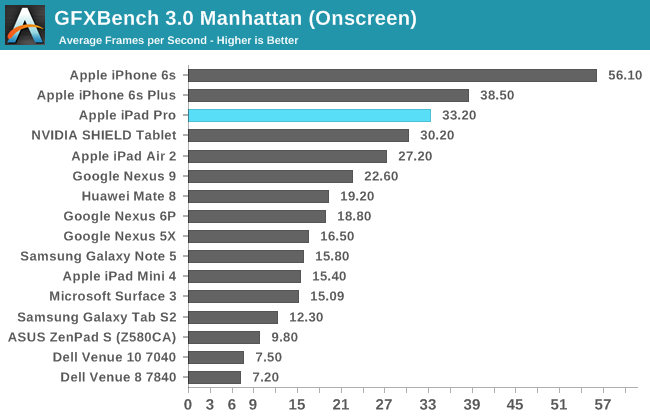

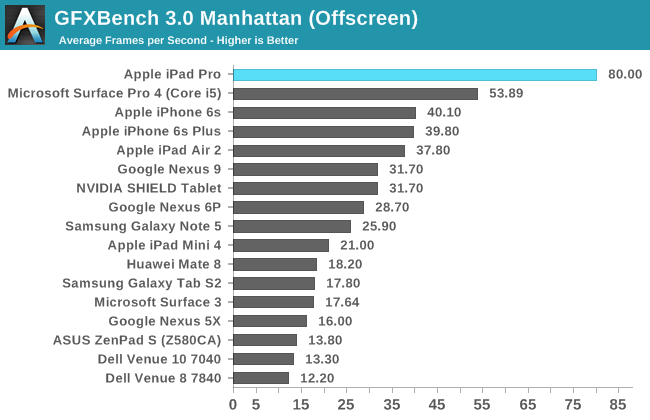
In GFXBench we can see the major benefits that really come with the larger GPU. It's pretty obvious here that clock speeds are basically identical when comparing the A9 GPU and A9X GPU as the scaling is almost perfectly double. In this benchmark the iPad Pro quite handily beats the Surface Pro 4, but it's important to keep in mind that the Surface Pro 4 is running a higher level of precision and that the iPad Pro is running OpenGL ES rather than OpenGL in this test, so it isn't strictly apples-to-apples (nor is such a thing truly possible at this time). Overall though the GPU of the iPad Pro is incredibly impressive, and I doubt that anyone will really have issues with gaming performance on this device.
NAND Performance
At this point it’s pretty well understood that storage performance can often be a gating factor in performance. Although caching is an amazingly effective method of hiding memory latency, for the first hit it’s mandatory to miss the cache unless you’ve managed to prefetch the data in question. The other issue where storage performance becomes obvious are cases where it’s necessary to commit data to storage first. Some cases where this is going to be obvious is app installation or iCloud restores, especially when network performance is at the point where installation can actually be gated by writing to disk rather than downloading from the network.
In the case of the iPad Pro, Apple claims that they’ve implemented a storage controller comparable to some desktop SSDs. It turns out that this controller is a familiar one, as the storage controller identifies itself as the APPLE SSD AP0128K in the case of this review unit. It turns out that everything about this SSD is identical to what we saw in the iPhone 6s as well, down the use of Hynix for at least one of the NAND vendors and the hybrid SLC/TLC architecture discussed in previous articles. In order to test how this storage solution performs we once again use Eric Patno’s StorageBench, which provides a rough analogue to AndroBench 3.6.
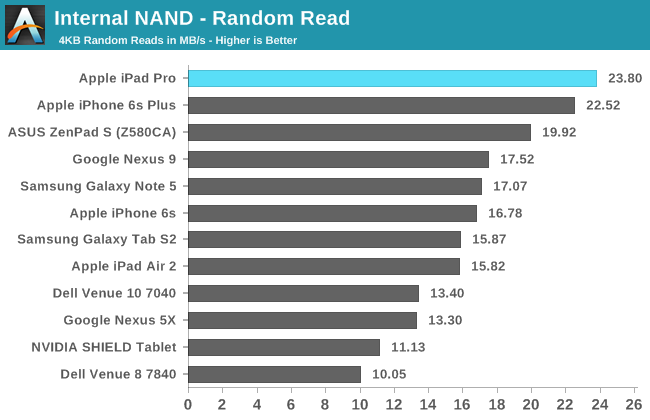

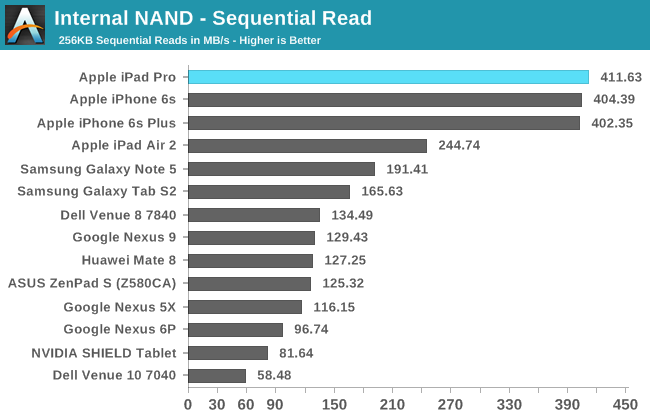
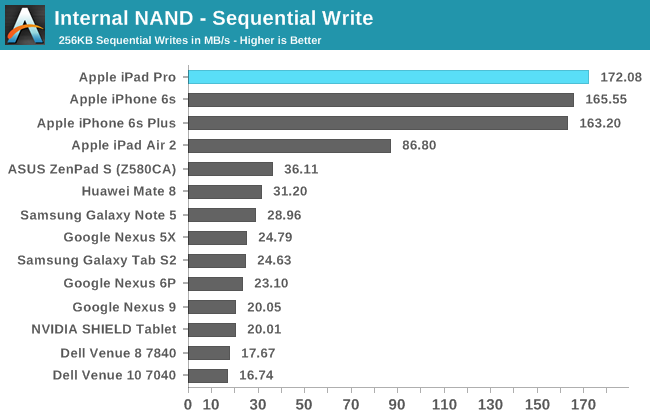
It turns out that in this test, performance is basically identical to the iPhone 6s. This isn’t quite the equal of something like the Surface Pro 4’s PM951 SSD, which has the advantage of more NAND dies working in parallel, but given that the iPad Pro PCB size isn’t going to be anywhere near that of the Surface Pro 4 it’s likely that this is a concession to gain better battery life. I definitely wonder what performance would be like relative to a Surface Pro 4 if the iPad Pro had a 512GB SKU, but given that the iPad Pro tops out at 128GB this isn’t really a question with a relevant answer.










408 Comments
View All Comments
nsteussy - Friday, January 22, 2016 - link
Well said.Wayne Hall - Friday, January 22, 2016 - link
WHAT IS MEANT BY PROFESSIONAL TASKS. I AM THINKING OF THE I-PAD PRO.gw74 - Friday, January 22, 2016 - link
Why do Apple only want content consumers' money in mobile, and not creators' too? Apple are in business to make a profit. If there was money to be made building workstation apps for mobile, it would happen. Furthermore "exploit their owners commercially" is just a pejorative way of saying "sell them stuff in return for money", i.e. "business".Sc0rp - Friday, January 22, 2016 - link
1) Apple made the pencil. I'm sure that they want creator's money too.2) The "Pro" market is incredibly small and fickle.
AnakinG - Friday, January 22, 2016 - link
I think Apple wants people to "think" they are creators and professionals. It's a feel good thing while making money. :)Constructor - Saturday, January 23, 2016 - link
The iPad Pro is a fantastic device for all kind of uses – I personally also use it as a mobile TV, streaming radio (due to its really excellent speakers), game console, internet and magazine reader (since it is pretty much exactly magazine-sized!), drawing board, note pad, multi-purpose communicator (mail, messaging, FaceTime etc.), web reader, ebook reader and so on...As to the numbers: According to an external survey it seems about 12% of all iPads sold in the past quarter were iPad Pros. We're talking about millions of devices there at the scale at which Apple is operating – most other tablet manufacturers and even PC manufacturers would kill for numbers like thes at prices like these!
It's almost funny how some people completely freak out about the iPad Pro because it crashes through their imaginary boundaries between their imaginary "allowed" kinds of devices.
The iPad Pro is a really excellent computer for the desktop (if for whatever reason an even bigger display is not available), which also works really well on my lap (actually much better and almost always more conveniently than a "laptop" computer!) and even in handheld use like a magazine or notepad. It's very light for its size, has a really excellent screen, excellent speakers and is fast and responsive.
Yeah, you can find things which you at this moment can't do on it yet. But there are many, many practically relevant uses at which it excels to a far greater extent than any desktop or notebook computer ever could.
jasonelmore - Sunday, January 24, 2016 - link
so you basically use it as a consumption and a communication device.. our point is, a professional cannot use this as their only computing device. they need PC's or MAC's to supplement it, which all use Intel or AMD.Until this fact changes, intel is far from being in trouble. iPad sales are in a huge slump as well, not just pc sales. Actually, Notebook PC sales are great, its the desktop that slows down every 3-4 years. iPhone is about to become a 0 growth product as well. Apple see's the writing on the wall, and that's why they are exploring cars, and other unknown products. The Chinese market never turned out like they had hoped, with stiff competition at low costs with similar quality.
Constructor - Sunday, January 24, 2016 - link
so you basically use it as a consumption and a communication device..Among many other things! So let me guess, when you happen to play some streaming music on your workplace computer or if you're watching the news on it, does it automatically turn into a "toy" and yourself into one of those mythical "only consumers" as well?
This silly ideology is really ludicrous.
our point is, a professional cannot use this as their only computing device. they need PC's or MAC's to supplement it, which all use Intel or AMD.
Nope.
Some portion of workplaces actually requires a desktop OS. This portion is not 100% but substantially lower than that.
A very large portion of workplaces (likely the majority) could very well use iPads as well, but external circumstances make regular PCs or Macs just more convenient and practical.
And some other portion can and does use mobile devices already now as their primary tools.
The tedious and absurd conclusion from people's own limited knowledge and imagination to absolute judgments of the entire market is anything but new, but it's really old news by now.
Until this fact changes, intel is far from being in trouble. iPad sales are in a huge slump as well, not just pc sales. Actually, Notebook PC sales are great, its the desktop that slows down every 3-4 years. iPhone is about to become a 0 growth product as well. Apple see's the writing on the wall, and that's why they are exploring cars, and other unknown products. The Chinese market never turned out like they had hoped, with stiff competition at low costs with similar quality.
You should seriously get better sources for your information as your imaginations are rather far off from actual reality.
Intel is already in a tightening squeeze between the eroding PC market (especially regarding its crumbling profitability) and the ever-rising development costs they face with their creaking x86 antiquity. That their CPU performance is stagnating at the same time is also increasingly problematic, too, since it puts another damper on the PC market.
When you're talking about Apple you clearly live in a different universe from the rest of us: Apple is actually booming in China while the cheap manufacturers have run into unexpected difficulties against them, and your other imaginations of Apple's doom are neither original nor do they have anything to do with the actual reality on the ground.
Even the iPad is a massive cash cow on a scale the competition can only dream about – it's just dwarfed by the absolute gigantic profits from the iPhone.
But yeah, surely that spells inescapable doom for the company.
Sure!
Coldmode - Friday, January 22, 2016 - link
This is the stupidest paragraph about computing I've ever read. It's equivalent to lamenting Bell's role in telephony because we managed to win World War 1 with telegraphs but now teenagers spend all their time hanging off the kitchen set chatting to one another about their crushes.ABR - Monday, January 25, 2016 - link
@ddriver I disagree with most of what you say in these contents, but, "today we have gigahertz and gigabytes in our pockets, and the best we can do with it is duck face photos," hits the nail on the head! The problem though is not that software developers don't try to do more, but that they can't make any money doing so. The masses just want to buy the latest duck photo app, and there's not enough of the pie left over to support much else. In the early days of the iPad this wasn't so, but nowadays take a look at the top charts in iOS to see what I mean. Games makes more than all others put together, and then even in categories like Utilities, you see mainly Minecraft aids, emoji texters, and a few web browser add-ons. Apple doesn't promote this in their advertising, but they do so in more subtle but effective ways like which apps they choose to feature and promote in the app store. In fact, the store is littered with all kinds of creativity- and productivity-unleashing apps if you search hard, but they all tend to die on the vine because they get swamped out by the latest glossy-image joke-text-photo-video apps and the developer loses interest.